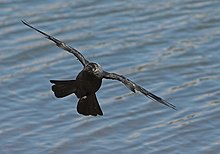Flight feather
The flight feathers of some birds perform additional functions, generally associated with territorial displays, courtship rituals or feeding methods.Ligaments attach the long calami (quills) firmly to the wing bones, and a thick, strong band of tendinous tissue known as the postpatagium helps to hold and support the remiges in place.[8] Corresponding remiges on individual birds are symmetrical between the two wings, matching to a large extent in size and shape (except in the case of mutation or damage), though not necessarily in the pattern.These feathers are especially important for flapping flight, as they are the principal source of thrust, moving the bird forward through the air.However, on the upstroke (when the bird often draws its wing in close to its body), the primaries are separated and rotated, reducing air resistance while still helping to provide some thrust.Secondary feathers remain close together in flight (they cannot be individually separated like the primaries can) and help to provide lift by creating the airfoil shape of the bird's wing.Loons, grebes, pelicans, hawks and eagles, cranes, sandpipers, gulls, parrots, and owls are among the families missing this feather.[18] Tertials arise in the brachial region and are not considered true remiges as they are not supported by attachment to the corresponding bone, in this case the humerus.These elongated "true" tertials act as a protective cover for all or part of the folded primaries and secondaries, and do not qualify as flight feathers as such.[22] These feathers may vary widely in size – in fact, the upper tail tectrices of the male peafowl, rather than its rectrices, are what constitute its elaborate and colorful "train".[23] The outermost primaries of large soaring birds, particularly raptors, often show a pronounced narrowing at some variable distance along the feather edges.By manipulating its thumb to create a gap between the alula and the rest of the wing, a bird can avoid stalling when flying at low speeds or landing.[30] Domestic pigeons have a highly variable number as a result of changes brought about over centuries of selective breeding.[31] In order to make the discussion of such topics as moult processes or body structure easier, ornithologists assign a number to each flight feather.[34] The outer primaries of the male American woodcock are shorter and slightly narrower than those of the female, and are likely the source of the whistling and twittering sounds made during his courtship display flights.[36] Both Wilson's and common snipe have modified outer tail feathers which make noise when they are spread during the birds' roller coaster display flights; as the bird dives, wind flows through the modified feathers and creates a series of rising and falling notes, which is known as "winnowing".Male standard-winged and pennant-winged nightjars have modified P2 primaries (using the descendant numbering scheme explained above) which are displayed during their courtship rituals.[38] In the standard-winged nightjar, this modified primary consists of an extremely long shaft with a small "pennant" (actually a large web of barbules) at the tip.Males of many species, ranging from the widely introduced ring-necked pheasant to Africa's many whydahs, have one or more elongated pairs of rectrices, which play an often-critical role in their courtship rituals.These plumes are raised up over the bird's head (along with a fine spray of modified uppertail coverts) during his extraordinary display.[41] The remiges of ratites are soft and downy; they lack the interlocking hooks and barbules that help to stiffen the flight feathers of other birds.As adults, their wings and tail are covered with the same small, stiff, slightly curved feathers as are found on the rest of their bodies.For most birds, moult begins at a certain specific point, called a focus (plural foci), on the wing or tail and proceeds in a sequential manner in one or both directions from there.In longer-tailed species, such as swallow-tailed kite, secretary bird and European honey buzzard, for example, juveniles have shorter rectrices than adults do.It is theorized that the differences help young birds compensate for their inexperience, weaker flight muscles and poorer flying ability.While there can be considerable variation across members of a species—and while the results are obviously impacted by the effects of moult and feather regeneration—even very closely related species show clear differences in their wing formulas.













Red kitepennaceous feathersthrustflightwoodpeckersposteriorLigamentstendinoussymmetricalmutationphalangesvorticesBald eaglegrebesstorksflamingosostrichespasserinescommon buzzardquill knobshummingbirdsalbatrosscovert feathersembryonicpelicanseaglescranessandpipersolecranonhumeraltectricespeafowlmallardalulaeanteriorangle of attackhoatzinsdigitscallusedrectricial bulbsratitesgrouseruffed grousehazel grousecommon snipeDomestic pigeonsornithologistslong-tailed paradise whydahbroad-tailed hummingbirdsnorthern lapwingAmerican woodcockclub-winged manakinsstridulationWilson'sstandard-wingedpennant-winged nightjarsring-necked pheasantwhydahslyrebirdsbirds of paradiseribbon-tailed astrapiamagnificent bird-of-paradisetreecreeperswoodcreepersPsalidoprocneStelgidopteryxDouble-wattled cassowarysteamer ducksTiticaca grebecassowarieskākāpōEurasian jackdawfamiliescourtship displaysArcticmigratinglatitudeswhite-bellied sea eaglepredatorswaterfowlwrynecksdendrochronologyswallow-tailed kitesecretary birdEuropean honey buzzardmathematicalring (band)chiffchaffwillow warblerEmpidonaxflycatchersdusky flycatcherHammond's flycatchercommon skylarkOriental skylarkBird anatomyBird flightDrumming (snipe)PinioningPlumageDelayed feathering in chickensBibcodeCambridge University PressEhrlich, Paul R.Sibley, DavidWayback MachineFeather tractscovertseye-ringspeculumsuperciliumOutlineAnatomyFeathersPreen glandVisionBehaviourSingingIntelligenceMigrationForagingSexual selectionLek matingSeabird breedingBrood parasitesNesting